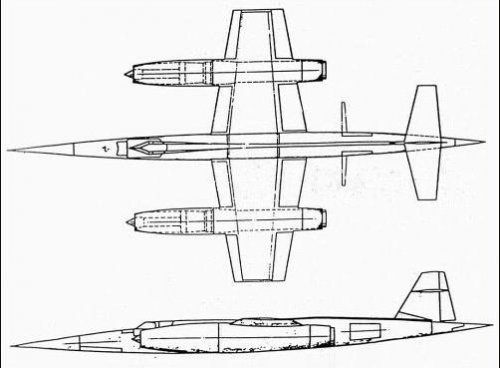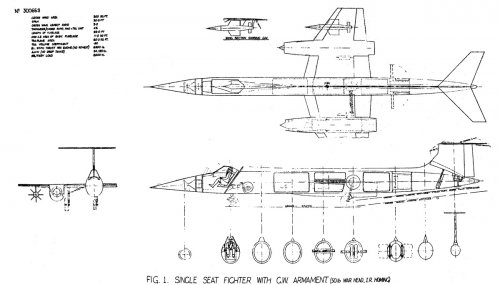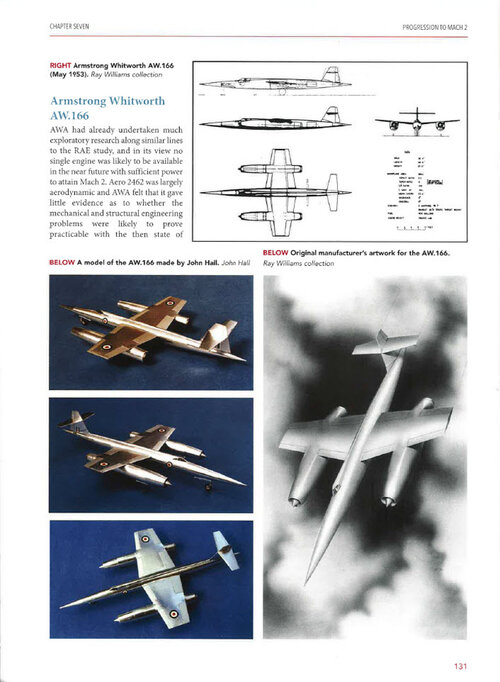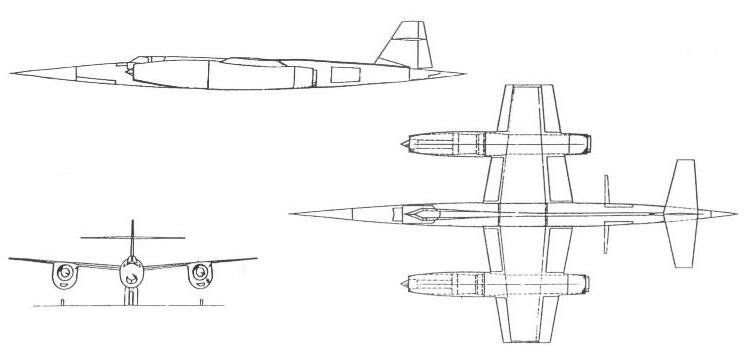You are using an out of date browser. It may not display this or other websites correctly.
You should upgrade or use an alternative browser.
You should upgrade or use an alternative browser.
Armstrong Whitworth AW.166 high-speed research aircraft
- Thread starter hesham
- Start date
-
- Tags
- cold war united kingdom
- Joined
- 20 January 2007
- Messages
- 953
- Reaction score
- 1,143
This Meteor-like layout was RAE's 1953 perception of stainless steel optimum for M3 cruise, funded 1955 as Avro 730 recce/later bomber. 1954 proof-of-concept funding was released, won by Bristol as T.188. AW.166 came second, but AWA/HSAL/HDA's manufacturing capability was esteemed, so Bristol was required to sub-contract wing fabrication to AWA, who were also to take a fabrication share of 730. Its 1957 cancellation caused UK industry to lose any yen for the residual research task, which drifted to first flight 14/4/62, and grounding, 12/1/64 (having reached, oddly, M.1.88). The value of the whole exercise was to cause UK to stick at M2.2 for its SST.
- Joined
- 27 December 2005
- Messages
- 17,752
- Reaction score
- 26,450
- Joined
- 27 December 2005
- Messages
- 17,752
- Reaction score
- 26,450
zen said:Curious, what is the engine for this RAE study?
2 x 4/9th scaled RB.106 turbojets with integral reheat. The single seat swept wing study, essentially a P1A, used a single RB.106 with long reheat (i.e mid mounted engine, jet pipe, then reheat in tail).
- Joined
- 22 April 2012
- Messages
- 2,258
- Reaction score
- 2,314
RB.106 again!
I was musing recently and wondered how awesome a English Electric P.8 would be with a pair of RB.106s and a Napier triple scorpion rocket!
I was musing recently and wondered how awesome a English Electric P.8 would be with a pair of RB.106s and a Napier triple scorpion rocket!
- Joined
- 9 October 2009
- Messages
- 21,979
- Reaction score
- 13,644
sealordlawrence said:RB.106 again!
I was musing recently and wondered how awesome a Lighting P.8 would be with a pair of RB.106s and a Napier triple scorpion rocket!
Have mercy on the poor maintainers, would you? ;D
- Joined
- 15 July 2007
- Messages
- 4,889
- Reaction score
- 4,554
2 x 4/9th scaled RB.106 turbojets with integral reheat.
Once again the answer raises its head. Its these scaled RB.106 types that resolve the issues they faced IMO, by focusing the latest technology on producing engines of similar thrust to the Avon but at smaller sizes and weights.
So we see EE's P.6D with 2/3 scale RB.106s (late '53), and Bristol's T.188 with similar (again late '53).
Consider the effect of such engines on the Lightning, Scimitar, Sea Vixen and even the Hunter. Smaller size means more volume free for fuel, more cross section tradable for area ruling, and more space to get at the engine for maintenence. It also makes it far easier to design a new twin engined fighter for either the RN or the RAF.
- Joined
- 22 April 2012
- Messages
- 2,258
- Reaction score
- 2,314
I am not even sure how much scaling would have been required, remember that the RB.106 was meant to be the same size as an Avon, just lighter and with higher thrust. And think it could have been used in multiple platforms to produce very high quality aircraft, I mentioned the English Electric P.8 earlier but the SR.177 also comes to mind as does the P.1121 for the scaled up RB.122 intended for the Fairey Delta III. I maintain that the cancellation of the RB.106 was a genuinely aweful decision.
- Joined
- 15 July 2007
- Messages
- 4,889
- Reaction score
- 4,554
I think the 2/3 power version is appropriate at 10,000lb static thrust and from the P.6D a reheat chamber diameter of no more than 33 inches.
This RAE design could do with looking at a canard variant for comparison. I have a nasty feeling their figures for military load are a bit off at 2,400lb.
The whole thing is rather long at 82ft, seems a bit excessive.
This RAE design could do with looking at a canard variant for comparison. I have a nasty feeling their figures for military load are a bit off at 2,400lb.
The whole thing is rather long at 82ft, seems a bit excessive.
blackkite
Don't laugh, don't cry, don't even curse, but.....
- Joined
- 31 May 2007
- Messages
- 8,819
- Reaction score
- 7,718
Attachments
Similar threads
-
Armstrong Whitworth AW.66 and AW.65 projects
- Started by hesham
- Replies: 10
-
-
-
Armstrong Whitworth AW.171 Super Sonic VTOL Flying Wing Project
- Started by GTX
- Replies: 17
-
Armstrong Whitworth AW.24 B9/32E Day Bomber Project
- Started by hesham
- Replies: 0




